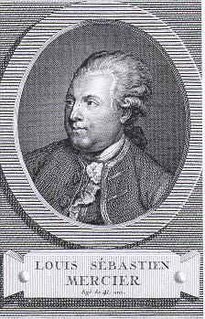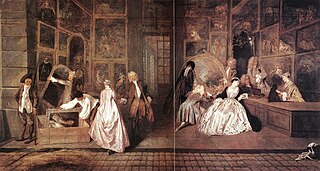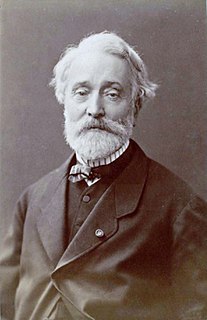Related Research Articles

Hector Guimard was a French architect and designer, and a prominent figure of the Art Nouveau style. He achieved early fame with his design for the Castel Beranger, the first Art Nouveau apartment building in Paris, which was selected in an 1899 competition as one of the best new building facades in the city. He is best known for the glass and iron edicules or canopies, with ornamental Art Nouveau curves, which he designed to cover the entrances of the first stations of the Paris Metro.

Louis-Sébastien Mercier was a French dramatist and writer, whose 1771 novel L'An 2440 is an example of proto-science fiction.
Richard Guino was a French sculptor of Catalan origin.

A marchand-mercier is a French term for a type of entrepreneur working outside the guild system of craftsmen but carefully constrained by the regulations of a corporation under rules codified in 1613. The reduplicative term literally means a merchant of merchandise, but in the 18th century took the connotation of a merchant of objets d'art. Earliest references to this Corps de la Ville de Paris can be found at the close of the 16th century, but in the 18th century marchands-merciers were shopkeepers but they also played an important role in the decoration of Paris homes. In fact, they served as general contractors, designing and commissioning pieces of the most fashionable furniture, and often, in addition, worked outside of their shops as interior decorators, responsible for many aspects of a room's decor. In Paris, the guild system, in place since the late Middle Ages, prohibited craftsmen from working with any material with which they had not undergone a formal apprenticeship. Only a marchand-mercier who worked outside of the guild system, therefore, could mount Chinese porcelains with gilt-bronze handles and stands, fit the cabinetmaker's furniture with Japanese lacquer or Sèvres porcelain plaques, and supply furniture with opulent gilt-bronze mounts.
Dominique Daguerre was a Parisian marchand-mercier who was in partnership from 1772 with Simon-Philippe Poirier, an arbiter of taste and the inventor of furniture mounted with Sèvres porcelain plaques; Daguerre assumed Poirier's business at La Couronne d'Or in the Faubourg Saint-Honoré in 1777/78. Daguerre commissioned furniture from ébénistes such as Adam Weisweiler, Martin Carlin and Claude-Charles Saunier, and menuisiers like Georges Jacob, for whom he would provide designs, for resale to his clients, in the manner of an interior decorator. A series of watercolours that Daguerre sent to Albert, Duke of Sachsen-Teschen, the brother-in-law of Marie Antoinette, who was refurnishing the castle of Laeken near Brussels, are at the Metropolitan Museum of Art

Louis-Simon Boizot (1743–1809) was a French sculptor whose models for biscuit figures for Sèvres porcelain are better-known than his large-scale sculptures.

Adam Weisweiler was a pre-eminent French master cabinetmaker (ébéniste) in the Louis XVI period, working in Paris.

Roger Vandercruse Lacroix (1728–1799), often known as Roger Vandercruse, was a Parisian ébéniste whose highly refined furniture spans the rococo and the early neoclassical styles. According to Salverte, he "is counted among the great ebenistes of his generation ."

Martin Carlin was a Parisian ébéniste (cabinet-maker), born at Freiburg, who was received as Master Ébéniste at Paris on 30 July 1766. Renowned for his "graceful furniture mounted with Sèvres porcelain", Carlin fed into the luxury market of eighteenth-century decorative arts, where porcelain-fitted furniture was considered among "the most exquisite furnishings" within the transitional and neoclassical styles. Carlin's furniture was popular amongst the main great dealers, including Poirier, Daguerre, and Darnault, who sold his furniture to Marie Antoinette and many amongst the social elite class. He died on 6 March 1785.

Pierre-Philippe Thomire (1751–1843) a French sculptor, was the most prominent bronzier, or producer of ornamental patinated and gilt-bronze objects and furniture mounts of the First French Empire. His fashionable neoclassical and Empire style furnishing bronzes established the highest standard in refined finish in the craft that the French called that of the fondeur-ciseleur, "founder-finisher". In his pre-Revolutionary training, Thomire appeared first as a ciseleur, in the division of duties that went into the production, for example, of a set of gilt-bronze wall-lights delivered for Marie-Antoinette's card-room, her Salon des Jeux at Compiègne: under the general supervision of Hauré, the wax and wooden model was carved by Martin, cast by Forestier, and chased by Thomire, as Pierre Verlet was able to show over fifty years ago.

Sèvres is a commune in the southwestern suburbs of Paris, France. It is located 9.9 kilometres from the centre of Paris, in the Hauts-de-Seine department, Île-de-France region. The commune, which had a population of 23,251 as of 2018, is known for its famous porcelain production at the Manufacture nationale de Sèvres, which was also where the Treaty of Sèvres (1920) was signed.
Joseph Baumhauer was a prominent Parisian ébéniste, one of several of German extraction. Having worked for some years as a journeyman for the German-born ébéniste François Reizell, he was appointed ébéniste privilegié du Roi in 1767, enabling him to skirt certain requirements of the Paris guild under royal privilege as well as a stiff entrance fee. He used the stamp ♣JOSEPH♣, the name by which he was commonly known to his contemporaries, between fleurs-de-lis emblematic of his royal appointment. Such stamps, like the long-mysterious B.V.R.B., served to mask the identity of cabinetmakers to the clientele of marchands-merciers, such as Lazare Duvaux, who owed the "ébéniste Joseph" 1726 livres at the time of his death. Furniture stamped by Baumhauer that is mounted with Sèvres porcelain plaques must have been commissioned and sold by Simon-Philippe Poirier, who maintained a monopoly of the production, having originally devised the decor. some furniture stamped by Joseph is veneered with panels of Japanese lacquer, another sure indication of the intervention of a marchand-mercier, who, rather than the cabinetmaker himself, was in a position to purchase Japanese screens and cabinets, have them disassembled and, once the wooden support of the lacquer surfaces had been planed down, applied as costly veneer panels. Other marchands-merciers for whom Joseph is known to have worked include Thomas-Joachim Hébert and Charles Darnault.

Bernard II van Risamburgh, sometimes Risen Burgh was a Parisian ébéniste of Dutch and French extraction, one of the outstanding cabinetmakers working in the Rococo style. "Bernard II's furniture is brilliant in almost every respect. His carcasses are beautifully shaped, his mounts and marquetry are always in complete balance even when extremely elaborate, and there is a logic to his works that allows the eye to comprehend them effortlessly," wrote Ted Dell.

Edmé-François Gersaint (1694–1750) was a Parisian marchand-mercier (merchant) who specialised in the sale of works of art and luxury goods and who is noted for revolutionising the art market by preparing, for the first time, detailed catalogs with descriptions of the work and biographies of the artist.

The Viaduc des Arts is a converted train line located in the 12th arrondissement of Paris which is now both a string of workshops for highly skilled artisans and, on the top level, a linear park. It was, formerly, the “Viaduc de Bastille,” for the trains of the Paris-Bastille-Vincennes line.
Nicolas Heurtaut was a French wood carver and furniture designer. He designed many pieces of furniture for the French royal family and the bourgeoisie. His furniture can be found in museums in Europe and the United States.
Lignereux is a French company, founded in 1787, which produces objets d'art. Established in Paris and London, Lignereux plays a major role in decorative arts. Lignereux makes objects which are intended for art collectors. In 2015 Lignereux began to produce new objects, decorated by contemporary artists and craftspeople.
Jacques-André Jacquelin was a French playwright, lyricist, chansonnier, goguettier and poet.

Joseph Servières was an early 19th-century French playwright.

Jules Diéterle was a 19th-century French architect, also a draftsman, painter, painter on porcelain, sculptor and theatre decorator.
References
- 1 2 3 4 5 6 7 8 9 10 11 12 13 Merceron, Jérôme (200). Martin-Eloy Lignereux marchand mercier à Paris à la fin du XVIIIème siècle (DEA). Université de Paris. OCLC 491898660. Supervised by Alain Mérot and Bill Pallot.
- ↑ This commercial agreement was arranged through banker Jean-Frédéric Perrégaux in April 1787.
- ↑ Original invoices confirm the importation of richly decorated mantelpieces from Paris, which were then adjusted by artisans in London.
- ↑ "Inventaire des laques anciennes et des objets de curiosité de Marie-Antoinette confiés à Daguerre et Lignereux". 142 pieces are entrusted to Lignereux and Daguerre, including objects made of lacquer, crystal and petrified wood. https://archive.org/stream/archivesdelartfr08guifuoft/archivesdelartfr08guifuoft_djvu.txt
- ↑ A secret note from the Prefect of Police states in 1807 that "in peacetime, the maison of Daguerre and Lignereux made a turnover of between 1 500 000 and 200 000 000 with foreign countries." [quoted in http://www.christies.com/lotfinder/LotDetailsPrintable.aspx?intObjectID=5474045]
- ↑ "La dynastie des Jacob": http://www.latourcamoufle.com/artistes-biographie/les-jacob/?language=en
- ↑ Pierre Verlet, Le Commerce des Objets d’Art et les marchands merciers à Paris au XVIIIe siècle, 1958: http://www.persee.fr/web/revues/home/prescript/article/ahess_0395-2649_1958_num_13_1_2705
- ↑ The Stamp of Adam Weisweiller appears on several pieces of furniture which were purchased from the boutiques of Lignereux, in particular in the (former) art collections of the Earls of Elgin and Quentin Craufurd.
- ↑ http://www.sevresciteceramique.fr/documents/inventaire_des_collections_documentaires_de_la_cita_=doc51.pdf Archived 2015-09-24 at the Wayback Machine p.31, Carton U4.
- ↑ This client list is quoted in the following note: http://www.piasa.auction.fr/_fr/lot/secretaire-de-dame-en-cabinet-il-est-en-placage-de-citronnier-hellip-2274399#.VTEnzmbXcfE http://www.piasa.auction.fr/_fr/lot/secretaire-de-dame-en-cabinet-il-est-en-placage-de-citronnier-hellip-2274399#.
- ↑ William Beckford is mentioned as a client of M.E. Lignereux's in the following notes: http://www.christies.com/lotfinder/LotDetailsPrintable.aspx?intObjectID=3933065 et http://www.sothebys.com/en/auctions/ecatalogue/lot.pdf.
- ↑ http://www.sothebys.com/en/auctions/ecatalogue/2011/property-from-the-collections-of-lily-edmond-j-safra-n08822/lot.749.html [ bare URL ]
- ↑ John Russell, 6th Duke of Bedford, made several acquisitions at Lignereux's during the Treaty of Amiens: http://www.sothebys.com/en/auctions/ecatalogue/2009/important-furniture-silver-ceramics-l09767/lot.16.html, http://files.shareholder.com/downloads/BID/56365219x0x331701/0140C153-FBB0-4516-93A0-84402AD67949/331701.pdf Archived 2015-06-05 at the Wayback Machine
- ↑ James Harris, ed. (1845). Diaries and Correspondence of The Earl of Malmesbury. Vol. 3. p. 284.